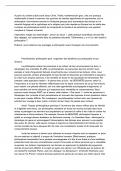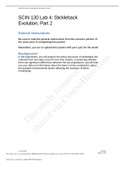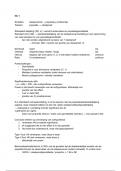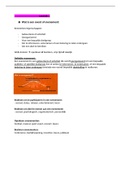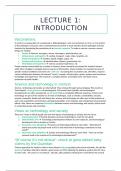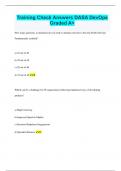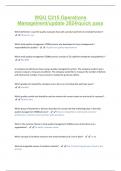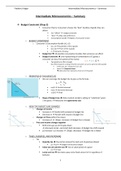Intro Lecture 11/11 Regulatory focus & Resistance
Focus course → shaping and presenting products, ideas, or movements in a way that motivates
people to engage and say ‘yes’ to (social influence)
Regulatory focus theory → based on prevention and promotion focus of people
• Prevention focus → example of Trump quotes → how can I avoid failing the course?
• Promotion focus → example of Harris quotes → how can I learn everything?
Don’t want to → fail, loose money, be rejected, look stupid, get sick (security, safety, duties)
Want to → enjoy, own things, learn, be fit, have friends (growth, learn, advance)
Scholar et al. 2019
• Everyone has a prevention and promotion focus
• Differences arise from chronic or temporal orientation
• Chronic orientations are orthogonal →independent → individuals can simultaneously
have strong prevention and promotion systems
• Temporal orientations are dependent → at any given time, one orientation is going to
dominate a situation
• Measured with questionnaire, e.g.:
o ‘I often think about the person I would ideally like
to be in the future’ (promotion)
o ‘I frequently think about how I can prevent
failures in my life’ (prevention)
The 4 parenting styles (permissive, authoritative, uninvolved,
authoritarian) → based on responsiveness and demandingness
Approach and avoidance systems related to
promotion/preventions systems (not the same because
approach and avoidance are not orthogonal) → being prevention or promotion oriented can
influence your way of thinking
Promotion system Prevention system
Approach Advancement Safety
Growth Security
‘Gain’ → way of thinking ‘Non-loss’ → way of thinking
Avoidance Deprivation Danger
Stagnation Threat
‘Non-gain’ → way of thinking ‘Loss’ → way of thinking
Motivational orientation differs systematically with …
• Age (Lockwood et al., 2005)
• Gender (McKay-Nesbitt et al., 2013)
• Culture (Kurman & Hui, 2011)
• Upbringing (Scholar et al., 2016)
• Type of decision (Zhou & Pham, 2004) → context influences prevention/promotion system
you are using
1
,People in a promotion focus…
• … have interest in promotion-oriented products
• … attend to promotion-oriented attributes
• … process information in an eager way
• … prioritize speedy decisions, less eye for detail
• … focus on obtaining the best option
• … are more creative
People in a prevention focus…
• … interested in prevention-oriented products
• … inspired by positive and negative role models
• … motivated by criticism about their work
• … prioritize accuracy to speed
• … focus on the details
• … focus on eliminating the worst option
• … are less creative
• … are more conservative
• … are more interdependent
• … have generally a lower self-esteem
Example sunscreen → ‘’give sunburn no change, Avène provides safe protection’’ (prevention-
focused) and ‘’enjoy the warm rays of the sun, Clarins for healthy tan’’ (promotion-focused)
Regulatory fit → a person’s motivation orientation leads them to prefer products and messages
that help them sustain her orientation
• Why → it makes them ‘feel right’ during message reception, it increases their strength of
engagement with the message
• It’s about the way it is presented → nonverbal promotion and prevention behavior →
attracts corresponding type of people
Transactional leaders → prevention focused followers
Transformational leaders → promotion focused followers → otherwise mismatch → e.g.
punishment for not being creative
Two ways to create fit → mismatch if you don’t take regulatory fit into account
1. Adjust the message to suit the audience
2. Adjust the audience to suit the message
a. Political campaigns will do both
Negativity bias → people are more likely to be hurt by negative effect, than they are going to be
happy by gaining something
The prevention and promotion focus is a focus and thus about something that will happen, but
not something that happened already → difference with negativity bias
2
,Resistance to change → four different forms:
1. Reactance → need for autonomy
a. People want to choose themselves
b. When you make them feel ‘pushed’, they are going to ‘push back’ and resist
2. Endowment → loss aversion
a. You prefer the status quo
b. They dislike losing something
3. Distance → social judgement theory
a. Too far from by backyard to even consider
4. Uncertainty → risk aversion
a. Genuine doubt because you see risks
Level of resistance → how will you get a movement going → how will my audience react and how
high will their resistance be? Will they be very resistant?
→ moderators of the level of resistance → social pressure, coercive marketing, lack of trust in
brand/provider, lack of autonomy/forced compliance, love & attachment to the status quo,
change to established routines, high cost or financial commitment, long-term consequences,
complexity and lack of familiarity, perceived risk and uncertainty
(1) Reactance → need of autonomy is threatened → based on self-determination theory → what
people need to feel happy → how to influence:
• Start with understanding → build community, trust etc
• Provide a menu → give people options
o Doesn’t always work → has to do with giving a feeling of not being ‘forced’
• Ask don’t tell → e.g. asking improved effectiveness of the campaign of smoking
(2) Endowment → loss aversion → people wanting to stay in the status quo → how to influence:
• Reduce switch costs → ensure it is not as ‘psychological expensive’ to make change →
e.g. persuading people to insulate their roof? Offer to help clean the attic!
o Now there are no costs for having to clean the entire attic
• Appeal to what people lost, but can get back → if you approach resistance in a way that
you’ve already lost something, but you want to bring it back
o E.g. let’s make USA great again
• Extra examples → you don’t want to change your phone → or suppose we do a coin flip →
heads: you win 102 euros, tails: you lose 100 euros → would you take the bet? → most
people not, because of loss aversion
(3) Distance → social judgment theory → how to influence:
• Offer needs to be in the latitude of acceptance → place where
they might accept the offer
o Any offer is going to be in one of the 3 places (latitude
of rejection, latitude of acceptance, current position)
o Depends on presentation → message will be in red, yellow or green → depends on
context/person → e.g. blockage of highways by farmers → message has higher
change of being in latitude of rejection, because you might get late to work
• How to influence → find the movable middle → people who are a bit open to the idea
(yellow, not red) → e.g. political campaigns focus on swing states
3
, (4) Uncertainty → risk aversion → might be interested, maybe too risky
• Uncertainty → outcome + probability of different outcomes is
unknown → e.g. exam result
• Risk → outcome is unknown, but probability of different
outcomes is known → e.g. coin flip always 50%
• How to influence:
o First you need innovators and early adopters,
but later you also have to mind the bigger group
of early and late majority
o Give people trial period → reduce uncertainty
Central problem (recap):
• Proposals for change themselves can induce a prevention focus
o Depending on the level of threat
• But change often needs promotion focus → focus on ideals, opportunities etc
• Effective social influence often starts with getting people ‘in the mood for change’
Some evidence-based ideas to elicit a ‘change mindset’/promotion focus:
• Asking people for their desires and aspirations → they will get into promotion focus
because they will start thinking about what they want
• People become more promotion focused by viewing nature → e.g. walking → it opens up
their mind
• Purchase decision is placed in the future (vs now) → more risk-oriented on short term
• Be creative!
Example Ben & Jerry’s → there was no option of bringing old flavors back → flavor graveyard in
Vermont (500.000 visitors a year): created a (online) cemetery to grieve the old flavors
Take home message: when introducing a new product/idea/solution:
1. Assess (potential) resistance → level of it, reasons for it, and the four different types
2. Acknowledge and address the resistance in a fitting way
3. When the path is clear, guide people toward a promotion focus
4

